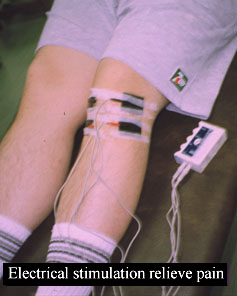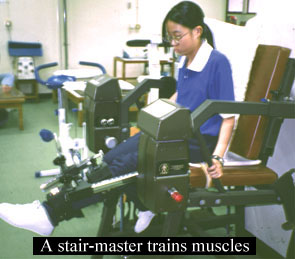Another battle between Chinese and Western medical practice
By Angela Yau
San-san is a name implying success and victory on the surface. But this level of success may be accompanied by unwanted things at the back: sports injuries.
People playing sports with inappropriate equipment or little warm-up easily get sports injuries, even when doing ordinary sports exercises or games.
Mr. Herman Lau, Physiotherapy Department head at Prince of Wales Hospital, said sports injury is defined as any injury related to sports.
He explained that people, especially athletes, generally suffer from sports injuries such as partial or complete muscle tears, ligament tears, lower limb fractures, sprained ankles and soft tissue injury.
Mr. Tong Cho Hau, 19, from Ma On Shan, once sprained his ankle while playing basketball.
 “I wore a pair of leather shoes to play the game after school and hurt my ankle,” he said.
“I wore a pair of leather shoes to play the game after school and hurt my ankle,” he said.
After 6 months, he visited a physiotherapist in Sha Tin to have a massage.
“After 1 to 2 weeks, my pain was relieved,” he said.
Orthopaedics and physiotherapy are two main ways to heal sports injuries. Physiotherapy is treatment by means of exercise and massage, and the use of light, heat and electricity and other natural forces.
Meanwhile, orthopaedics is the branch of surgery dealing with bone deformities and diseases.
Both of them can be carried out in Chinese and Western ways.
Chinese methods are usually performed by bonesetters and herbalists while Western ones are done in clinics and hospitals.
Mr. Chan Fat, a bonesetter in North Point, said bonesetting is very useful in treating sports injuries like broken bones.
Said Mr. Chan: “We usually apply herbs to massage the injured area.
“If bones are broken, some bone-joining herbs will be applied to the injured part and the bones are fixed stationary with a pair of planks.”
While Western doctors employ operations and plaster or fibreglass casts, Chinese doctors practise dual treatment: herbal drink and massage.
To Mr. Aaron Chow, a basketball team member at The Chinese University of Hong Kong, Chinese type of healing is more effective.
He felt great pain in his waist after prolonged exercises and training.
Then he went to Queen Elizabeth Hospital.
“The doctor said I only suffered from pulled muscle.
“He gave me some rubbing cream and anodyne to lessen my pain,” Mr. Chow said.
“However, it didn’t help at all,” he continued.
After that, he went to consult Mr. Benny Ng, a herbalist.
He gave Mr. Chow treatment similar to that from a bonesetter.
“First, he used some sort of radiation to accelerate my blood circulation. Then, he massaged my injured part with some cream and herbs,” Mr. Chow said.
Besides, Mr. Ng advised him to do some exercises and swim the breaststroke regularly to help muscle relaxation.
Before Mr. Ng, Mr. Chow had visited other doctors.
He received interferential therapy and transcutaneous electrical nerve stimulation to relieve pain.
 However, he thinks a bonesetter is more professional in treating general sports injuries.
However, he thinks a bonesetter is more professional in treating general sports injuries.
On the other hand, Mr. Fong Tai Hung of Kwai Chung trusted Western methods when he had a ligament tear because of their more advanced equipment.
“I had seen a bonesetter for four weeks after the injury,” said Mr. Fong. After half a year, his leg muscles began to contract. He was so afraid that he went to South Kwai Chung Arthroscopy and Sports Injury Clinic to have investigation and treatment.
“After an X-ray checkup, the doctors found that I had a serious ligament tear. I started to receive physiotherapy such as leg presses,” he said.
Mr. Lau said, “Physiotherapy means physical therapy. It is tailor-made for sports injuries.”
Here is the regimen: Assessment, planning, treatment and evaluation.
“First, observation of any acute inflammation is carried out.
“Then, RICE treatment — Rest, Ice therapy, Compression of the injured area and Elevation — will be then given,” Mr. Lau said.
“Compression is used to prevent swelling and elevation to accelerate blood circulation,” he continued. Whatever treatment is made, the basic principle is to help patients cope with their daily activities.
Apart from the treatment, education is also a vital part of physiotherapy.
“We try to explain to the patients the cause and method to prevent injuries,” said Mr. Lau. He does not recommend people to visit bonesetters when they have sports injuries.
“There is no licensing policy for the bonesetters and herbalists in Hong Kong, so their quality is difficult to control,” he explained.
Mr. Lau gave the ultimate solution to sports injuries: “We would remind people to do enough warm-up and wear good fitting shoes and clothes before playing sports.”

October 1996
